While tomatoes tend to thrive in home gardens, they can sometimes be plagued by disease.
Three different types of blight may strike – early, late, and Septoria blight.
What’s a poor gardener to do?
By keeping a close eye on your plants, and starting treatment as soon as possible if you detect one of these insidious diseases, there may be hope for your crop!

We link to vendors to help you find relevant products. If you buy from one of our links, we may earn a commission.
This guide will show you how to distinguish between these diseases, prevent them, and treat the infection.
Here’s what’s ahead in this article:
What You’ll Learn
A Rundown of the Culprits
There are three types of blight that affect tomato plants. Spots on the leaves are the first indication of each of these infections. However, they all have their quirks that allow you to distinguish between them.
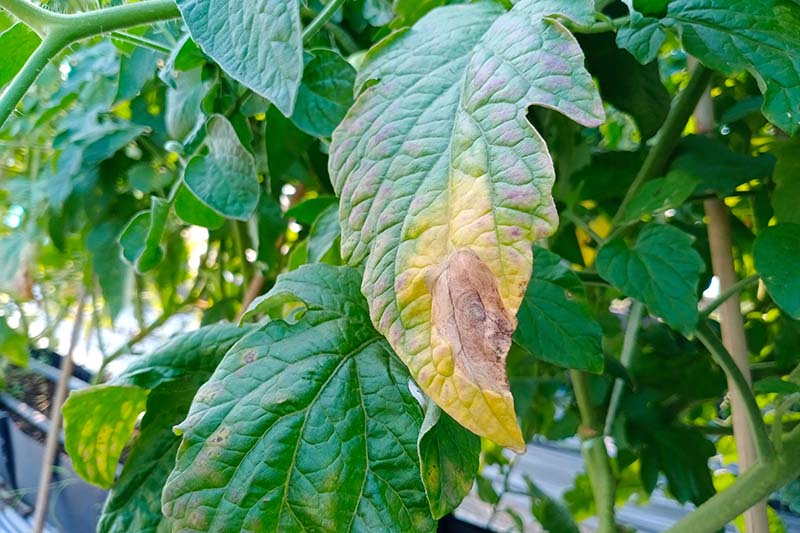
Two are caused by fungi – early blight (Alternaria solani) and Septoria blight, aka Septoria leaf spot (Septoria lycopersici).
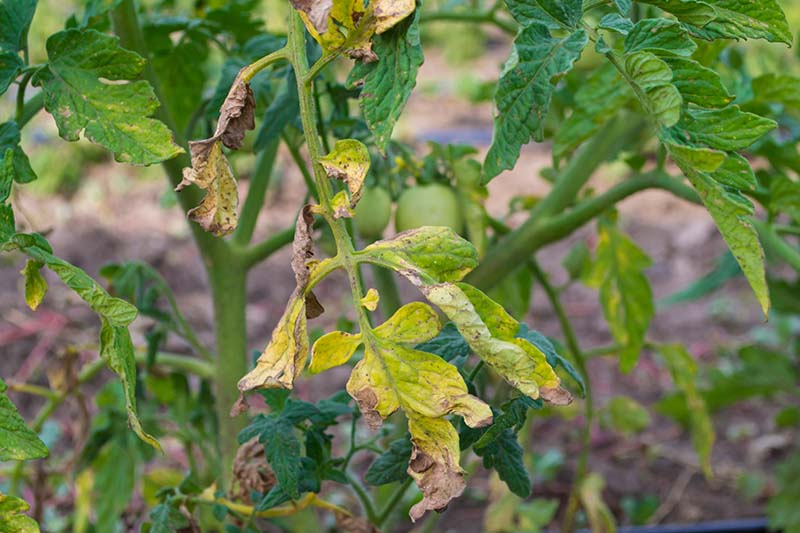
The third – late blight (Phytophthora infestans) – was considered a fungus for 200 years. However, it is now known as a water mold (or oomycete, to be technical).
This organism is what caused the Irish potato famine, forever altering Irish and American history.
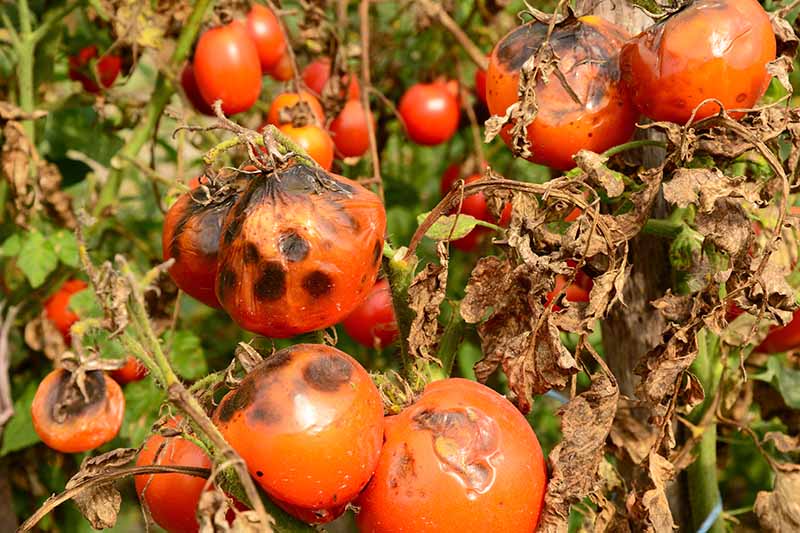
Alternaria and Septoria can devastate your crop at home, while late blight is an extremely serious infection that can decimate whole tomato fields.
Late blight is such a menace that you are advised to inform your county extension agent if you find it in your garden.
Read more about identifying late blight here.
Early blight and Septoria are often confused, since each of these infections causes the leaves to yellow and die. And both of these infections start on the lower leaves.
However, it is possible to tell them apart. Here’s how:
- Alternaria produces lesions with concentric rings that can also affect the fruit. They appear on the lower leaves first.
- Septoria leaf lesions, on the other hand, usually present as numerous tiny brown spots that grow and spread.
- Advanced Septoria leaf lesions contain dark colored fruiting bodies that look like grains of pepper. Alternaria does not produce any comparable structures.
- The lesions of late blight look different from those caused by fungi. They start out as little spots that look like they are soaked with water before spreading into large purple-brown blotches that appear oily.
- This water mold can also infect the fruit in cases of late blight, typically starting on the shoulders.
Check out our in-depth guides to learn more about early blight, and Septoria leaf spot.
Prevention
Prevention is your best bet in the battle against all of these diseases, and in some cases you can nip them in the bud (or leaves, or fruit…).
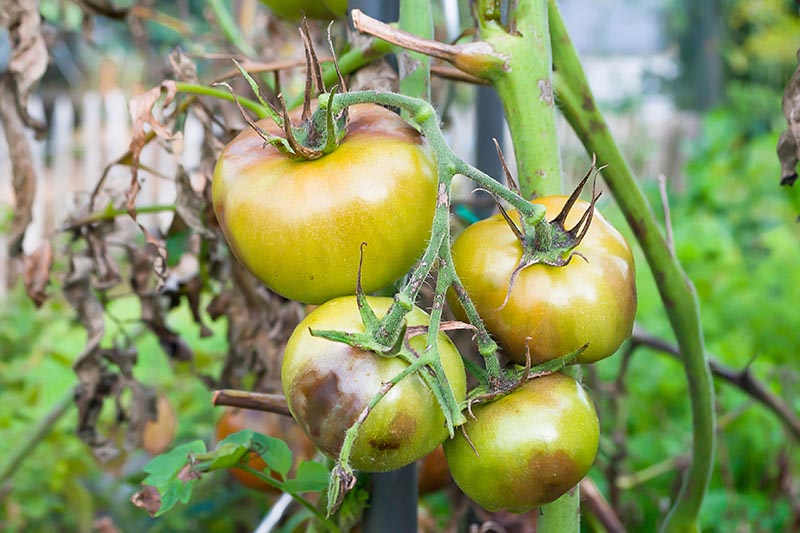
While these diseases are all caused by different types of microbes, there are common steps that you may employ to prevent infection.
Plan Your Garden
Before you start planting, plan the layout of your garden with the help of your gardening journal.
Locate your tomato plants away from areas where you want to grow potatoes or other nightshades.
Check your seed packets to establish mature sizes of the varieties you are growing. This allows you to ensure adequate spacing between plants, to prevent the spread of disease.
Grow Resistant Varieties
When choosing your plants, particularly if you know blight has been a problem in the past, choosing to grow resistant varieties is recommended. Information about resistance to different types of disease is typically included in tomato cultivar descriptions.
Resistance to early blight is usually labeled “EB” on tomato seed packets.
Keep in mind that resistance is not the same thing as immunity. Tomato plants that are resistant to early blight can sometimes contract the disease anyway.
Resistance to late blight is more difficult for plant breeders to select for, since the water molds mutate quickly and have been able to overcome resistance in the past.
However, the cherry tomato cultivar ‘Magic Mountain,’ available from Burpee, is resistant to both early and late blight.
‘Iron Lady’ and ‘Defiant’ are two cultivars that are resistant to early, late, and Septoria blight.
Though it is not quite at the level of being resistant, the ‘Sweetheart of the Patio’ cultivar is tolerant of late blight, and it’s well-suited to growing in containers.
You can read more about this variety and find out where to purchase seeds in our roundup of the best cherry tomatoes to plant in your garden.
Stake Your Plants
Promoting good airflow will also help to reduce the levels of moisture in the interior of the plant. Staking your plants prevents fruit and foliage from coming in contact with the ground.
Check out our guide to learn more about using the Florida weave to support tomato plants.
Fertilize
Ideally you should test your soil before you plant, to make sure the pH is between 6.5 and 7.5, and to determine whether there are any nutrient deficiencies.
At this time, before your seeds or transplants are in the ground, you should amend your soil accordingly.
After that, don’t fertilize your tomato plants again when they are young. Wait until they are well established and blooming before you fertilize again.
Fertilizers with an NPK ratio of 5-20-5 or 4-12-4, with the highest level of phosphorus in comparison to the amounts of nitrogen and potassium, are good choices.
If you need to add nitrogen, on the basis of your soil test results, also apply calcium nitrate at the same time. This will help to avoid blossom-end rot.
Do not add urea or ammonia as nitrogen fertilizers, as tomato plants are very sensitive to ammonium toxicity. This can result in yellowing of the leaves and poor root development.
Remove Weeds
Members of the nightshade family serve as hosts for all of these diseases. Such beloved crops as tomatoes, potatoes, and eggplant are all members of this family.
It also includes common weeds like nightshade and jimsonweed, as well as ground cherry.
All of these types of plants can harbor the pathogens, so be vigilant, and purge them from your garden! This includes volunteer tomato plants as well.
Irrigate at Ground Level
Watering your plants from above can invite infection. This is particularly true in the case of sprinkler irrigation, but even using a watering can can be an unhealthy practice if water is showered onto the foliage.
Instead, use a soaker hose to provide drip irrigation at the ground level. If your plants are growing in containers, make sure you water at the soil line.
Avoid Wet Conditions
Since all of these diseases are spread by water, resist the urge to work with your tomato plants in any way if they are moist. This includes moisture from rain, dew, and irrigation.
On wet days, it’s best to skip checking your plants for pests or picking any pests from the leaves. Do not prune when plants are wet, and wait to stake or train plants that require additional support or adjustment until they are dry.
You should even avoid going out to harvest tomatoes in this type of weather. If an extended period of rain is in the forecast, consider picking the fruit in advance of inclement weather, or wait until plants have dried again.
Apply Mulch
This may not seem like an obvious step, but an application of mulch can also help to prevent contaminated soil from touching the leaves.
Another benefit is that it can reduce the amount of humidity around your tomato plants. Lower humidity means any spores present are less likely to germinate and cause an infection.
However, you should wait until the soil has warmed up to apply mulch. Add three to four inches of organic mulch around the base of plants about three to five weeks after planting.
Grass clippings, wood chips, or straw that is free from weed seeds are all good choices.
Remove Infected Plants
Be vigilant about removing infected plants. In the case of late blight, all plants, including those that are not showing symptoms, should be removed and destroyed.
If you had a blight infection at some point during the growing season, bag up all the tomato plants and remove them from your property.
Do not add any of the plant material to your compost pile, and be sure to remove all parts, including the roots and any fallen debris.
Growers with fields should disc them deep underground, so that they will decay.
Rotate Your Crops
It’s human nature to want to keep growing plants in the same place where they have done well in the past.
However, this practice can favor infection.
Even if you didn’t observe any infections the previous season, the pathogens could be lurking at low levels, waiting to strike at an opportune moment. Rotating your crops will prevent this from happening.
You should rotate your nightshade crops every year, just to be safe. If you had a problem with Septoria blight last season, make that every two to three years.
And if you absolutely cannot rotate your tomato plants since you are short on space in the in-ground beds, consider growing them in containers instead.
If you are reusing the containers, sterilize them with 10 percent bleach first, and always use fresh soil.
In the case of late blight, Jean Ristaino et al, in an article published by the American Phytopathological Society, recommend planting non-host crops in a two to three-year rotation.
Treatment
It is possible to control Septoria if you catch the infection early enough. Aggressively remove the infected leaves and purge them from your property.

Do not add the material to your compost pile, and dispose of it in the trash, away from your garden.
Simply removing infected plant matter will not control early or late blight. You will need to use fungicides to manage these infections.
Fortunately, you have several options.
You can use the same kind of fungicide to treat each of these diseases. Apply them every seven to 10 days throughout the season.
If your weather is conducive to the spread of these diseases (i.e. humid and/or rainy), you can also consider using preventative sprays before the onset of an infection.
While the products described here have all been shown to be effective, fungi can develop resistance to fungicides if they are used frequently.
Check your plants periodically to ensure that the treatment is still working. If it isn’t, you may need to change which type of fungicide you are using.
Fortunately, all of the fungicides recommended here are in different classes, so you should be safe switching between them.
Organic Fungicide
If you are looking for an organic fungicide to use, you are in luck!
Bonide Liquid Copper Fungicide
Copper will kill all of these organisms. You can buy Bonide Liquid Copper Fungicide from Arbico Organics.
Synthetic Fungicide
Many of the fungicides commonly used to treat tomato diseases will treat all of these blights.
One thing to remember with the fungicides listed here is that you should stop using them five days before you plan to harvest your tomatoes.
Your choices include:
1. Chlorothalonil – Bonide Fung-onil Concentrate, available from Amazon
2. Maneb
Biofungicide
One of the microbes commonly used in the biological control of plant diseases is effective against early blight.
It is a strain of the bacterium Bacillus subtilis, which is also known as CEASE Biological Fungicide, available at Arbico Organics.
Learn more about using B. subtilis in your garden with this guide.
Inspect Your Plants Frequently
As with any infection, your best odds of success for treating these tomato diseases is largely dependent on whether you are able to catch them early enough.
Make a point to inspect your tomato plants on a regular basis, so that you can identify an infection in its early stages. The official term for this is “scouting.”

While you might be able to stop Septoria blight from spreading if you catch it early enough, that is not the case for early or late blight.
But you can eradicate the plants from your garden to prevent further spread, and take steps to protect any tomatoes that you wish to grow next year.
Starting an aggressive campaign with fungicides as soon as you detect an infection – or even preventively, if the conditions are conducive to the spread of blight – may help to save your tomato crop.
Have you had to fend off one of these diseases? If so, let us know how you fared in the comments below.
And read on to learn about other disorders that can strike tomatoes:
- How to Identify and Prevent Catfacing of Tomatoes
- Tomato Big Bud Disease: Symptoms and Prevention Options
- Identify and Treat Tomatoes with Sclerotinia Stem Rot
- Identify and Treat Septoria Leaf Spot on Tomatoes
© Ask the Experts, LLC. ALL RIGHTS RESERVED. See our TOS for more details. Product photos via Arbico Organics and Burpee. Uncredited photos: Shutterstock. With additional writing and editing by Allison Sidhu and Clare Groom.
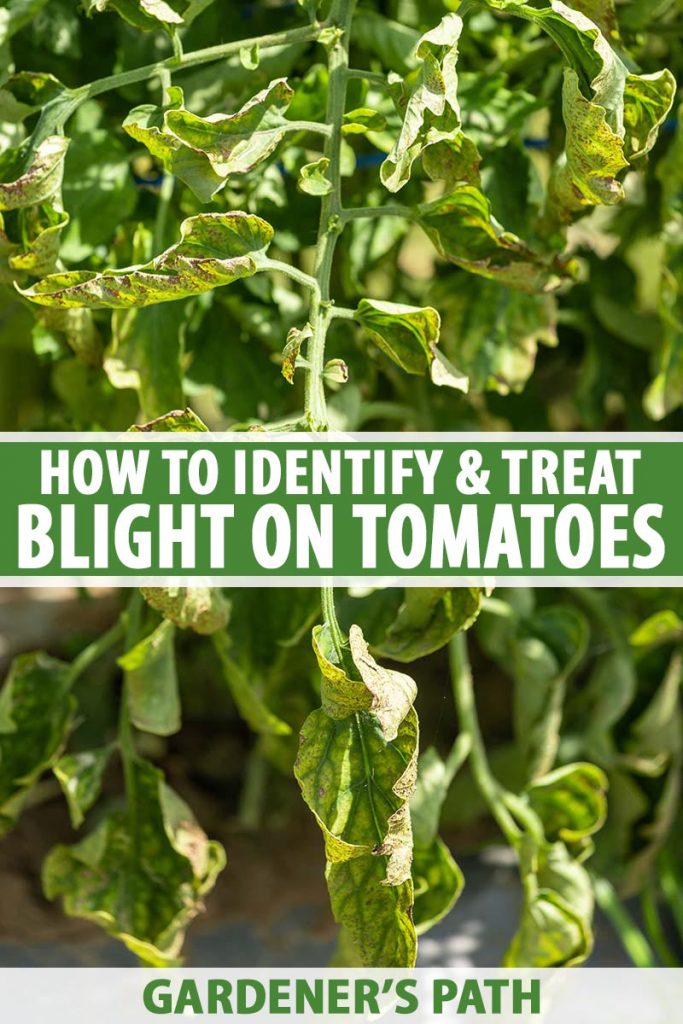
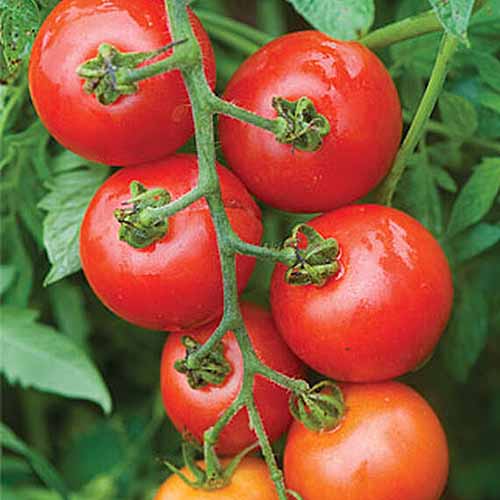
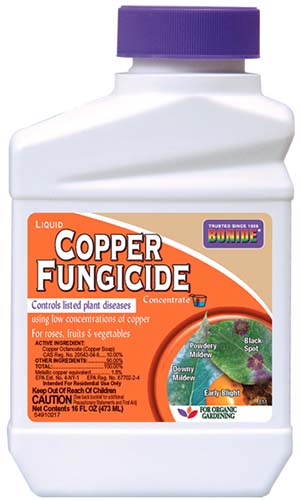
I love this article. I am just about going into tomato farming so I had one tomato planted to have a little experience about what it takes to cultivate tomatoes. It was just infested with diseases. All the diseases listed in this article, I find in my plant. However, with this information I know just about what to do next. And I have learned too. Thank you.
Hi Abiodun,
Thank you for taking the time to write! That is so kind of you. I’m sorry that your tomato is infested with multiple diseases – hopefully not late blight! I’m so glad that the article has advice that you can use, and I wish you the best with your tomato farming.
My tomato plants had what I believe was septoria last season. We mistakenly shredded the infected plants and used them in the garden. Last fall, I sprinkled the soil with baking soda. Is there anything else I can do? If I don’t plant tomatoes this year and wait until next year, will that help? Are there any plants/flowers I could plant to combat the disease? Thank you.
Hi Linda, if you want to wait out the infection, you’ll need to give it three years. You could grow your tomatoes in containers or perhaps put them in a different area/raised bed for a few years, if possible. If not, you can treat the soil with a copper fungicide. You might want to treat it several times and turn the soil over each time before you plant. Septoria can be stubborn.
Have grown tomatoes for 40 years. Am now growing in 4×6 planters. 7 varieties of tomatoes. Seeing a blight I’m unfamiliar with. The leaves are all yellowing. Eventually the body of the plant develops black spots. Do you know what this is?
This sounds a lot like Septoria leaf spot rather than a blight. Do you have any images you can share? We also have a guide that is worth checking out. It can help you identify and address a leaf spot situation.
So educative May God bless you because you have opened My eyes